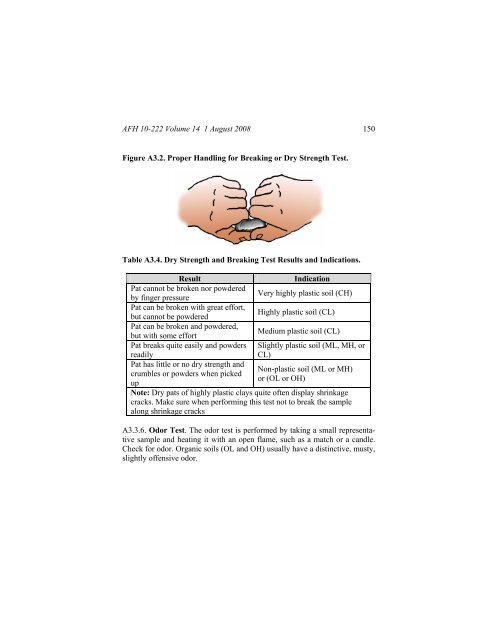Civil engineer guide to fighting positions, shelters, obstacles
Civil engineer guide to fighting positions, shelters, obstacles
Civil engineer guide to fighting positions, shelters, obstacles
Create successful ePaper yourself
Turn your PDF publications into a flip-book with our unique Google optimized e-Paper software.
AFH 10-222 Volume 14 1 August 2008 150<br />
Figure A3.2. Proper Handling for Breaking or Dry Strength Test.<br />
Table A3.4. Dry Strength and Breaking Test Results and Indications.<br />
Result Indication<br />
Pat cannot be broken nor powdered<br />
by finger pressure<br />
Very highly plastic soil (CH)<br />
Pat can be broken with great effort,<br />
but cannot be powdered<br />
Highly plastic soil (CL)<br />
Pat can be broken and powdered,<br />
but with some effort<br />
Medium plastic soil (CL)<br />
Pat breaks quite easily and powders Slightly plastic soil (ML, MH, or<br />
readily<br />
CL)<br />
Pat has little or no dry strength and<br />
crumbles or powders when picked<br />
up<br />
Non-plastic soil (ML or MH)<br />
or (OL or OH)<br />
Note: Dry pats of highly plastic clays quite often display shrinkage<br />
cracks. Make sure when performing this test not <strong>to</strong> break the sample<br />
along shrinkage cracks<br />
A3.3.6. Odor Test. The odor test is performed by taking a small representative<br />
sample and heating it with an open flame, such as a match or a candle.<br />
Check for odor. Organic soils (OL and OH) usually have a distinctive, musty,<br />
slightly offensive odor.
















